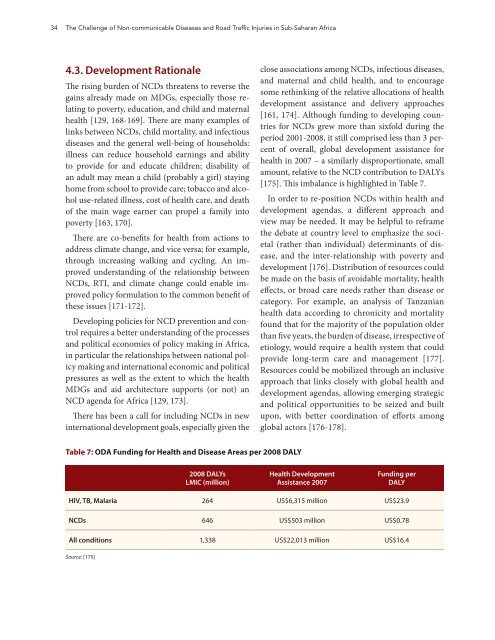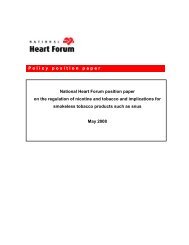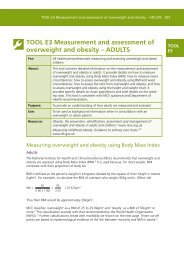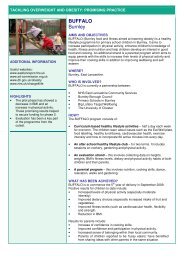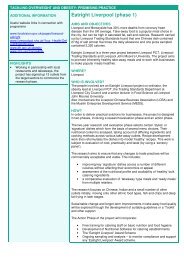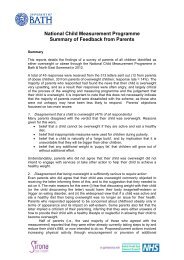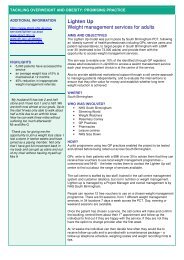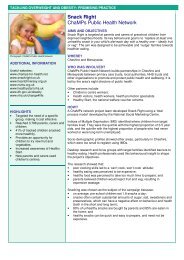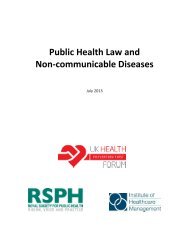The Challenge of Non-Communicable Diseases and Road Traffic ...
The Challenge of Non-Communicable Diseases and Road Traffic ...
The Challenge of Non-Communicable Diseases and Road Traffic ...
You also want an ePaper? Increase the reach of your titles
YUMPU automatically turns print PDFs into web optimized ePapers that Google loves.
34 <strong>The</strong> <strong>Challenge</strong> <strong>of</strong> <strong>Non</strong>-communicable <strong>Diseases</strong> <strong>and</strong> <strong>Road</strong> <strong>Traffic</strong> Injuries in Sub-Saharan Africa<br />
4.3. Development Rationale<br />
<strong>The</strong> rising burden <strong>of</strong> NCDs threatens to reverse the<br />
gains already made on MDGs, especially those relating<br />
to poverty, education, <strong>and</strong> child <strong>and</strong> maternal<br />
health [129, 168-169]. <strong>The</strong>re are many examples <strong>of</strong><br />
links between NCDs, child mortality, <strong>and</strong> infectious<br />
diseases <strong>and</strong> the general well-being <strong>of</strong> households:<br />
illness can reduce household earnings <strong>and</strong> ability<br />
to provide for <strong>and</strong> educate children; disability <strong>of</strong><br />
an adult may mean a child (probably a girl) staying<br />
home from school to provide care; tobacco <strong>and</strong> alcohol<br />
use-related illness, cost <strong>of</strong> health care, <strong>and</strong> death<br />
<strong>of</strong> the main wage earner can propel a family into<br />
poverty [163, 170].<br />
<strong>The</strong>re are co-benefits for health from actions to<br />
address climate change, <strong>and</strong> vice versa; for example,<br />
through increasing walking <strong>and</strong> cycling. An improved<br />
underst<strong>and</strong>ing <strong>of</strong> the relationship between<br />
NCDs, RTI, <strong>and</strong> climate change could enable improved<br />
policy formulation to the common benefit <strong>of</strong><br />
these issues [171-172].<br />
Developing policies for NCD prevention <strong>and</strong> control<br />
requires a better underst<strong>and</strong>ing <strong>of</strong> the processes<br />
<strong>and</strong> political economies <strong>of</strong> policy making in Africa,<br />
in particular the relationships between national policy<br />
making <strong>and</strong> international economic <strong>and</strong> political<br />
pressures as well as the extent to which the health<br />
MDGs <strong>and</strong> aid architecture supports (or not) an<br />
NCD agenda for Africa [129, 173].<br />
<strong>The</strong>re has been a call for including NCDs in new<br />
international development goals, especially given the<br />
close associations among NCDs, infectious diseases,<br />
<strong>and</strong> maternal <strong>and</strong> child health, <strong>and</strong> to encourage<br />
some rethinking <strong>of</strong> the relative allocations <strong>of</strong> health<br />
development assistance <strong>and</strong> delivery approaches<br />
[161, 174]. Although funding to developing countries<br />
for NCDs grew more than sixfold during the<br />
period 2001-2008, it still comprised less than 3 percent<br />
<strong>of</strong> overall, global development assistance for<br />
health in 2007 – a similarly disproportionate, small<br />
amount, relative to the NCD contribution to DALYs<br />
[175]. This imbalance is highlighted in Table 7.<br />
In order to re-position NCDs within health <strong>and</strong><br />
development agendas, a different approach <strong>and</strong><br />
view may be needed. It may be helpful to reframe<br />
the debate at country level to emphasize the societal<br />
(rather than individual) determinants <strong>of</strong> disease,<br />
<strong>and</strong> the inter-relationship with poverty <strong>and</strong><br />
development [176]. Distribution <strong>of</strong> resources could<br />
be made on the basis <strong>of</strong> avoidable mortality, health<br />
effects, or broad care needs rather than disease or<br />
category. For example, an analysis <strong>of</strong> Tanzanian<br />
health data according to chronicity <strong>and</strong> mortality<br />
found that for the majority <strong>of</strong> the population older<br />
than five years, the burden <strong>of</strong> disease, irrespective <strong>of</strong><br />
etiology, would require a health system that could<br />
provide long-term care <strong>and</strong> management [177].<br />
Resources could be mobilized through an inclusive<br />
approach that links closely with global health <strong>and</strong><br />
development agendas, allowing emerging strategic<br />
<strong>and</strong> political opportunities to be seized <strong>and</strong> built<br />
upon, with better coordination <strong>of</strong> efforts among<br />
global actors [176-178].<br />
Table 7: ODA Funding for Health <strong>and</strong> Disease Areas per 2008 DALY<br />
2008 DALYs<br />
LMIC (million)<br />
Health Development<br />
Assistance 2007<br />
Funding per<br />
DALY<br />
HIV, TB, Malaria 264 US$6,315 million US$23.9<br />
NCDs 646 US$503 million US$0.78<br />
All conditions 1,338 US$22,013 million US$16.4<br />
Source: [175]


